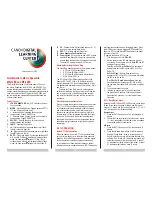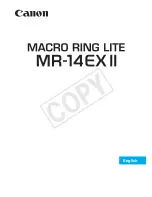
Close-up Photography
Exposure Compensation for Close-up Photography
35
When working very close to the subject, the exposure must be in-
creased. The actual exposure factor will vary in accordance with the dis-
tance that the lens is extended. (Optical law: Light intensity decreases by
the square of the distance from the film plane).
Exposure compensation is easily determined by referring to the Expo-
sure Compensation Scale.
After focusing the lens, read the exposure compensation factor on the
scale. The scale is divided into three zones of light, medium, and dark
shades. As indicated by the table at the base of the scale, the light zone
represents an exposure factor of zero (no compensation is necessary),
the medium shaded zone ind0.5 (a 1/2 stop increase in exposure
is required), while the dark zone denotes a factor of +1 (a full stop
increase in exposure is necessary).
To find the exposure factor, first locate the figure on the Focal Length
Scale for the lens in use. Next, move along the scale, in the same
column, until you reach the Distance Graduation. The shading of the
zone (light, medium, dark) which touches the Distance Graduation
indicates the correct exposure factor. For example, when the 110mm lens
is focused as shown in the illustration, the correct exposure factor is +1.
The scale curve for each lens has a white O mark which coincides with
the right-hand lens indication. So, use the mark to find the corresponding
scale curve for each lens.
With a factor of +0.5, open the aperture by a half-stop. For example,
assume that a hand-held exposure meter indicates a normal exposure
reading of f /16 at 1/60 sec., for an exposure compensation of +1, set the
lens to either f /16 at 1/30 sec. or f/11 at 1/60 sec.
When using a Mamiya through-the-lens (TTL) Exposure Meter Finder,
such as the RZ AE Prism Finder, it corrects automatically for close-up
photography.
• For optimum sharpness at the corners when using the 50 mm and
65mm wide-angle lenses at distances closer than 1 meter, use as small
an aperture as possible.
• The bellows extension in millimeters appears on the top of the Focal
Length Scale. These figures are used to determine the required
exposure compensation factor when using extension tubes.
• For areas covered with the bellows fully extended, see the instructions
for all interchangeable lenses.







































